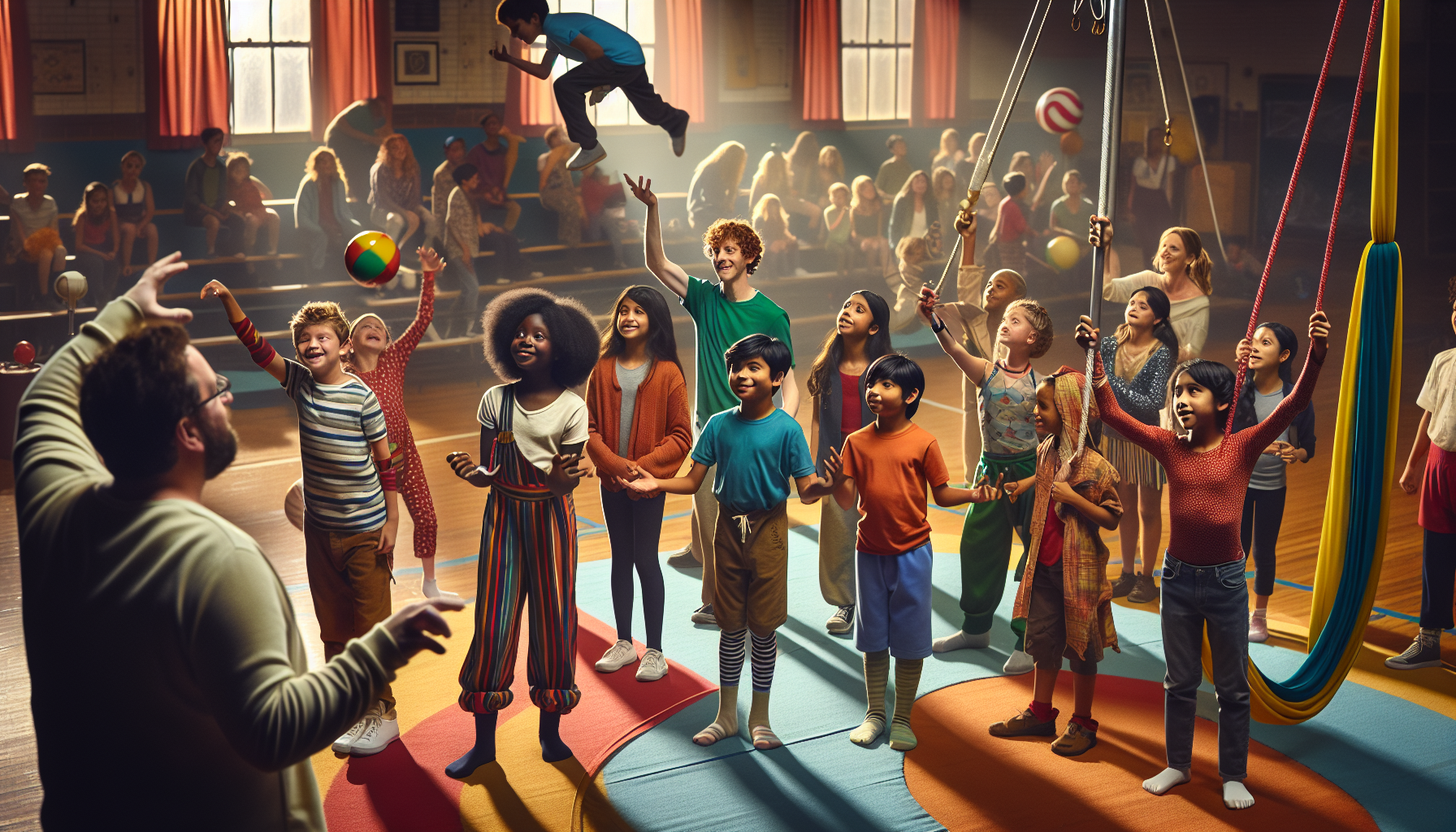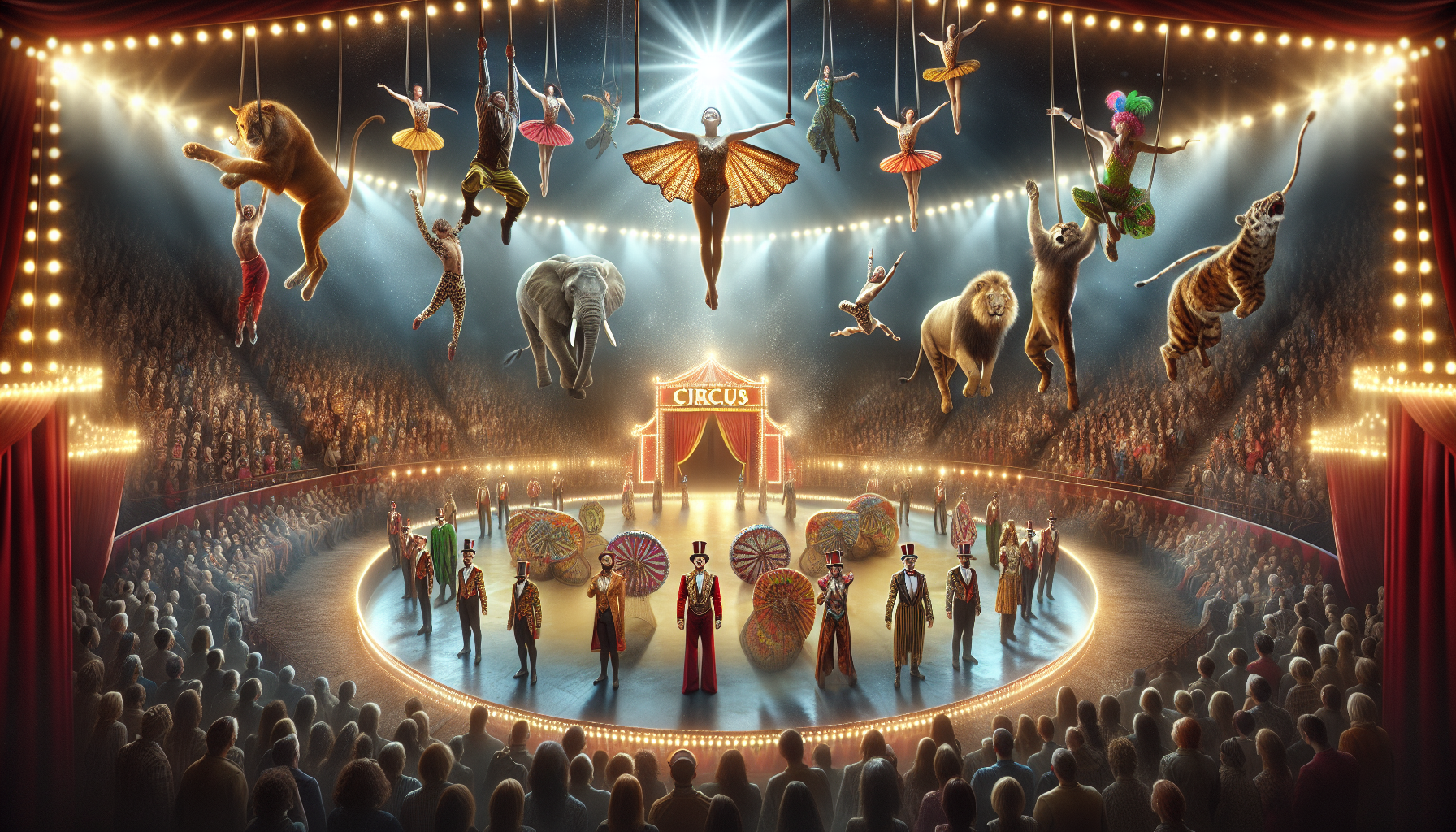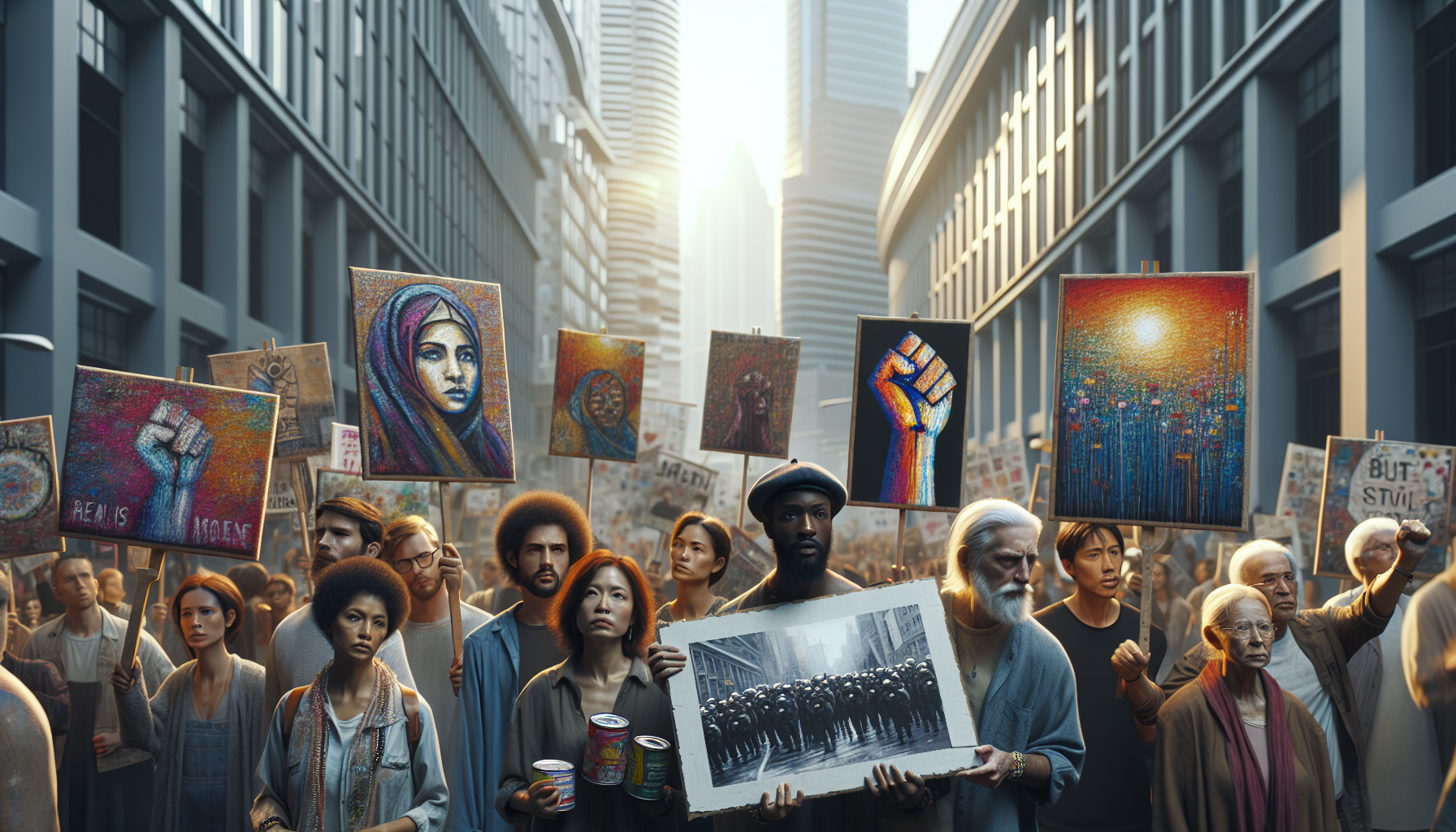In a world increasingly driven by technology and digital interactions, the concept of creativity in education often finds itself trapped within the confines of screens and standardized testing. Yet, beyond the conventional classrooms and rigid curricula lies a vibrant, dynamic, and transformative form of expression waiting to be unleashed: circus art. Imagine a learning environment where juggling, acrobatics, and clowning become the foundation for cognitive development and emotional intelligence. A place where imagination takes center stage and learning is not just a process but an exhilarating performance. Welcome to the world of circus art in education—a realm where creativity knows no bounds and students discover the joy of learning through the art of spectacle. 🎪
This article embarks on a journey through the colorful tent of circus arts, exploring how these ancient traditions are redefining educational paradigms. At first glance, the circus may seem like mere entertainment, a fleeting escape into a world of whimsy. However, delve deeper and you will uncover a treasure trove of pedagogical possibilities. From building confidence and fostering teamwork to enhancing problem-solving skills and promoting physical fitness, circus arts offer a holistic approach to education that engages the mind, body, and spirit. The transformative power of circus arts lies in their ability to break down the barriers between teacher and student, turning the learning experience into an interactive, collaborative, and deeply personal adventure.
Throughout this exploration, we will uncover stories of schools and educators who have embraced circus arts as a tool for transformation. We will meet students who have found their voices through clowning, learned resilience through aerial silks, and discovered the magic of mathematics through juggling. These stories highlight the unique ability of circus arts to cater to diverse learning styles and needs, offering inclusive and adaptable education that resonates with every student. Moreover, we will discuss how circus arts cultivate empathy and social awareness, equipping students with the emotional intelligence necessary to navigate an increasingly complex world.
As we navigate the chapters of this narrative, key insights into the practical implementation of circus arts in educational settings will be revealed. We will examine successful case studies and hear from pioneering educators who have witnessed firsthand the profound impact of incorporating circus arts into their curricula. Furthermore, we will delve into the challenges and triumphs of this innovative approach, providing a roadmap for schools and institutions eager to harness the full potential of circus arts. Ultimately, this article seeks to inspire educators, parents, and policymakers alike to reconsider the role of creativity in education, advocating for a future where learning is as joyful and limitless as the circus itself. So, step right up and prepare to be amazed by the transformative power of circus art in education! 🤹♂️
Introduction to Circus Art in Education
Circus arts have long been associated with entertainment, mystique, and a showcase of physical prowess. However, beyond the mesmerizing performances under the big top, circus arts possess a transformative potential, particularly in educational settings. This article explores how circus art, with its unique blend of creativity, physical activity, and skill development, can significantly impact the educational landscape.
Integrating circus arts into education provides a multidimensional approach to learning. It encourages students to engage both their minds and bodies, fostering a holistic development that traditional educational methods might overlook. By exploring the various facets of circus arts, educators can cultivate environments that nurture creativity, teamwork, and resilience among students. The potential for circus art to revolutionize learning experiences lies in its ability to blend physical discipline with creative expression, offering a dynamic educational tool that resonates with students of all ages.
In the educational sphere, the emphasis is often placed on cognitive learning, sidelining the importance of physical and emotional development. Circus arts present an opportunity to bridge this gap, encouraging students to explore their physical capabilities while simultaneously enhancing their cognitive skills. As students learn to juggle, perform acrobatics, or master clowning techniques, they not only build physical strength and coordination but also develop critical thinking, problem-solving skills, and emotional intelligence.
The Impact of Circus Arts on Physical Development
Circus arts demand a level of physical engagement that is both challenging and rewarding. Activities such as aerial silks, tightrope walking, and acrobatics require students to push their physical limits, enhancing their strength, flexibility, and balance. This physical development is essential, as it lays the foundation for a healthy lifestyle and a positive relationship with one’s body. By participating in circus arts, students gain a greater awareness of their physical capabilities and limitations, which can lead to improved self-esteem and body image.
Moreover, circus arts promote an active lifestyle, encouraging students to stay physically fit. Unlike conventional sports, circus arts offer a wide variety of activities that cater to different interests and abilities. This inclusivity ensures that every student can find a niche within circus arts that aligns with their physical aptitude and personal interests. The diversity of circus disciplines means that students can explore various physical challenges, from the elegance of aerial performances to the strength required in partner acrobatics.
The physical benefits of circus arts extend beyond strength and flexibility. Students involved in circus training often experience enhanced coordination and balance, crucial skills that translate into improved performance in other physical activities. The repetitive nature of practicing circus skills also instills discipline and perseverance, teaching students the value of hard work and dedication. These qualities, nurtured through physical development in circus arts, prepare students for challenges both inside and outside the educational context.
Table: Comparison of Physical Benefits
| Activity | Benefits |
|---|---|
| Aerial Silks | Improves upper body strength, flexibility, and coordination. |
| Juggling | Enhances hand-eye coordination and concentration. |
| Acrobatics | Builds overall body strength, balance, and flexibility. |
The Role of Circus Arts in Developing Creativity
Creativity is at the core of circus arts. From crafting unique performances to developing new tricks, students are encouraged to think outside the box and explore their artistic capabilities. This creative expression is not limited to performance alone; it permeates every aspect of circus arts. Whether designing costumes, choreographing routines, or conceptualizing new acts, students learn to harness their imagination in ways that foster innovative thinking.
The creative process in circus arts also nurtures problem-solving skills. Students are often faced with challenges that require creative solutions, such as figuring out how to execute a difficult maneuver or how to effectively communicate with partners during an act. These situations teach students to approach problems with an open mind and to experiment with different strategies until they find a successful outcome. The iterative nature of this process builds resilience and adaptability, essential qualities in both artistic and everyday contexts.
Engagement in circus arts also boosts students’ confidence in their creative abilities. As they receive encouragement and feedback from instructors and peers, students learn to trust their instincts and embrace their unique creative voice. This empowerment is vital, as it motivates students to take risks and express themselves authentically. The supportive environment of circus arts, where experimentation and innovation are celebrated, helps students to overcome self-doubt and fosters a culture of creativity.
Video: The Transformative Power of Circus Arts
Watch this inspiring video on how circus arts transform education and personal development: Circus Arts in Education – Inspire Creativity
Enhancing Emotional and Social Skills through Circus Arts
Circus arts offer more than just physical and creative benefits; they play a crucial role in developing emotional and social skills. Participation in circus activities requires collaboration and communication, as many acts involve teamwork and trust between performers. This collaborative environment fosters social interaction, helping students to build meaningful relationships and develop essential interpersonal skills.
Through circus arts, students learn to navigate social dynamics and manage their emotions effectively. Performing in front of an audience, for instance, can be a daunting experience that requires students to cope with nerves and anxiety. By regularly facing such challenges, students develop emotional resilience and learn techniques to manage stress and perform under pressure. These skills are invaluable in both personal and professional contexts, equipping students with the tools they need to navigate complex social situations confidently.
- Collaboration and teamwork are central to circus arts.
- Students develop emotional resilience through performance experiences.
- The inclusive environment fosters a sense of belonging and community.
Integrating Circus Arts into the Curriculum
The integration of circus arts into educational curricula can enhance traditional learning methods by providing experiential learning opportunities that engage students on multiple levels. Educators can incorporate circus arts into physical education, arts programs, and extracurricular activities, creating a diverse learning environment that caters to various learning styles and interests.
Incorporating circus arts into physical education classes can revitalize students’ engagement with physical activity. The novelty and excitement of circus disciplines motivate students to participate actively, often leading to increased enthusiasm for physical fitness. Additionally, circus arts can complement existing arts programs by offering an alternative form of artistic expression that challenges students to think creatively and collaborate with their peers.
Extracurricular circus programs provide students with opportunities to explore their interests outside the traditional classroom setting. These programs often attract students who might not engage with conventional sports or arts activities, offering a unique platform for self-expression and personal growth. By participating in circus arts, students can develop a well-rounded skill set that enhances their overall educational experience.
Table: Benefits of Integrating Circus Arts in Education
| Integration Area | Benefits |
|---|---|
| Physical Education | Increases student engagement and promotes physical fitness. |
| Arts Programs | Encourages creative expression and collaborative learning. |
| Extracurricular Activities | Provides a platform for personal growth and self-expression. |
The transformative power of circus arts in education is undeniable. By fostering physical, creative, emotional, and social development, circus arts offer a holistic approach to learning that prepares students for the challenges of the future. As educators and institutions continue to explore innovative methods to enhance education, the inclusion of circus arts presents a valuable opportunity to enrich students’ learning experiences and unleash their full potential.

Conclusion
Unleashing Creativity: The Transformative Power of Circus Art in Education has taken us on a journey through the vibrant and dynamic world of circus arts and their profound impact on educational systems. This article explored the innovative intersection where creativity meets learning, showcasing how circus arts can be a powerful tool for personal and academic growth.
We began by understanding the origins of circus arts and their evolution into a contemporary educational practice. By tracing its history, we saw how these vibrant art forms have transcended their traditional boundaries, moving from entertainment to educational contexts. Circus arts are not merely about performance; they are about cultivating a sense of discipline, teamwork, and creative expression among learners. This unique combination of physical, emotional, and intellectual engagement offers a holistic approach to education, fostering a conducive environment for students to thrive.
A critical point of discussion was the myriad of skills that students can develop through circus arts. From enhancing motor skills and physical fitness to nurturing creativity and problem-solving abilities, circus arts offer a multi-faceted platform for skill development. We examined how juggling, acrobatics, and clowning, for instance, help in improving concentration, coordination, and emotional resilience. These activities also promote perseverance, as students learn to embrace failure as a stepping stone to success, thus building a growth mindset that is invaluable in any learning process.
Furthermore, the article highlighted the role of circus arts in fostering social skills and emotional intelligence. In a world where digital interactions often overshadow face-to-face communication, the collaborative nature of circus arts encourages students to work together, trust each other, and communicate effectively. The shared experience of learning and performing circus acts nurtures empathy and understanding, breaking down social barriers and fostering inclusivity.
Incorporating circus arts into educational curricula can also lead to enhanced engagement and motivation among students. By providing an alternative to traditional classroom settings, circus arts capture the interest of diverse learners, including those who might struggle with conventional teaching methods. The element of fun and excitement inherent in circus activities makes learning an enjoyable experience, which can significantly boost student participation and retention rates.
Moreover, we discussed how educators and institutions can integrate circus arts into their programs. Successful implementation requires thoughtful planning and collaboration with experienced practitioners who understand the pedagogical potential of circus arts. Schools that have embraced this approach have reported positive outcomes, with students demonstrating improved academic performance and heightened enthusiasm for learning.
The article also addressed potential challenges, such as resource allocation and the need for trained instructors. However, these obstacles are surmountable with commitment and creativity. Schools can seek partnerships with local circus organizations, apply for grants, or incorporate circus arts into after-school programs to gradually introduce this transformative practice.
In conclusion, the integration of circus arts into education is not just an innovative teaching strategy; it is a movement towards a more inclusive, engaging, and effective educational system. By embracing the transformative power of circus arts, educators can unlock the full potential of their students, equipping them with the skills and mindset necessary to navigate an ever-changing world.
As we move forward, let us continue to explore and champion creative approaches in education. Whether you are an educator, a parent, or a student, consider how circus arts can play a role in your learning journey. Share this article with others who might be interested in alternative educational practices and join the conversation by leaving your thoughts and experiences in the comments section. Together, we can redefine education and unleash the creativity that lies within every learner.
For further reading on the impact of circus arts in education, visit resources like Circus Arts Education and American Youth Circus Organization. These platforms offer insights, research, and guidance for those interested in incorporating circus arts into educational settings.
🌟 Let’s embrace the magic of learning through creativity and transform the future of education, one circus act at a time. 🌟
Toni Santos is a visual storyteller and archival artisan whose creative journey is steeped in the bold colors, dramatic typography, and mythic imagery of old circus posters. Through his artistic lens, Toni breathes new life into these once-lurid canvases of wonder, transforming them into tributes to a golden era of spectacle, showmanship, and cultural fantasy.
Fascinated by the visual language of vintage circuses — from roaring lions to gravity-defying acrobats, from hand-painted banners to gothic typefaces — Toni explores how these posters once captured the imagination of entire towns with nothing more than ink, illusion, and a promise of awe. Each composition he creates or studies is a dialogue with history, nostalgia, and the raw aesthetics of entertainment on the move.
With a background in handcrafted design and visual heritage, Toni blends artistic sensitivity with historical insight. His work traces the forgotten typographies, chromatic choices, and symbolic flair that defined circus marketing in the 19th and early 20th centuries — a time when posters were not just advertisements, but portable portals to dreamworlds.
As the creative force behind Vizovex, Toni curates collections, illustrations, and thoughtful narratives that reconnect modern audiences with the magic of old circus art — not just as ephemera, but as cultural memory etched in paper and pigment.
His work is a tribute to:
The flamboyant storytelling of early circus posters
The lost art of hand-lettered show promotion
The timeless charm of visual fantasy in public space
Whether you’re a vintage print enthusiast, a circus history lover, or a designer inspired by antique aesthetics, Toni invites you into a world where tigers leap through fire, strongmen pose in perfect symmetry, and every corner of the poster whispers: Step right up.




